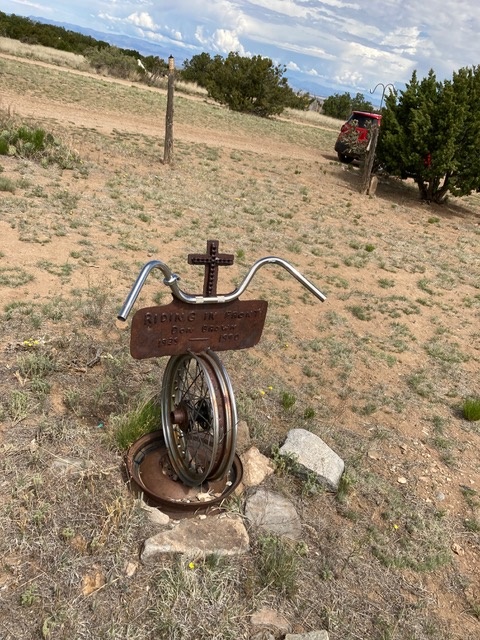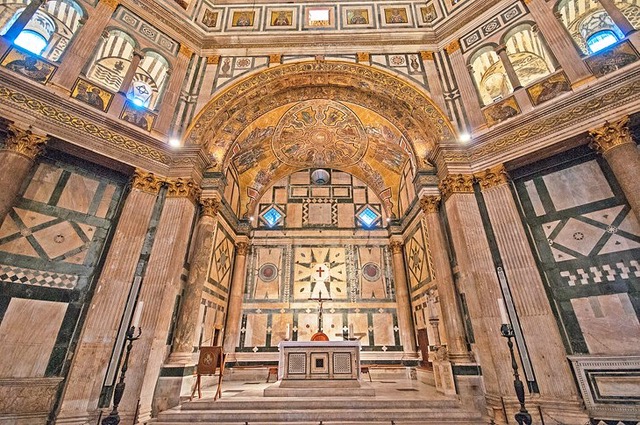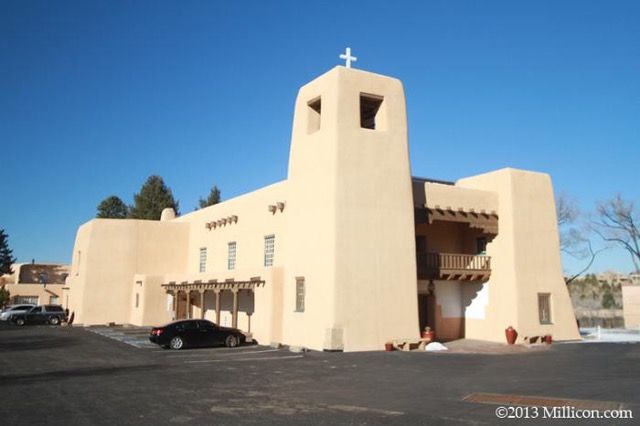It was a normal trip for Kate
Messervy Kingsbury – two months of dust, mud, gnats, mosquitoes and
heat, plus the occasional swollen stream, wildfire, hailstorm, strong
wind, blizzard and ever-present peril of Ute or Apache Indian attack.
She disliked both of her previous treks, but knew that this, her
third such punishing journey, offered the last, best hope for
survival. Then, just east of Dodge City, Kansas her husband John
opened a crate labeled “private stores” – and inside it was a
zinc-lined casket.
“The
Case of the Curiously Convenient Coffin!” True crime TV from CBS’s
48 Hours or NBC’s Dateline? No. Just another tale from the Santa
Fe Trail – one of New Mexico’s most historic transportation
avenues.
Each
of New Mexico’s major eras – Pre-Columbian, Spanish Colonial,
Mexican and United States – had its own major artery – the
North-South Indigenous Trade Route, El Camino Real de Tierra Adentro,
Santa Fe Trail and Atchison, Topeka, and Santa Fe Railway (AT&SF.)
Long
before the Europeans arrived the kingdoms and tribes of northern
Mexico set up the NORTH-SOUTH INDIGENOUS TRADE ROUTE into present day
Colorado to swap items such as turquoise, obsidian, salt and feathers
with Native Americans.
Built
from this original pathway EL CAMINO
REAL was a 1,600 mile long road linking Mexico City and San
Juan Pueblo, 40 miles north of Santa Fe. Used as a trade route by
the Spanish Colonials from 1598 to 1821 and – since the mother
country forbade business dealings with anyone else – THE ONLY
source of commerce and culture into New Mexico.
SANTA FE TRAIL was an 800-mile wagon route connecting Missouri and
Santa Fe between 1821 and 1880. (Mexico, unlike Spain, welcomed
outside trade, especially from United States.) After the U.S. -
Mexico War ended in 1848, it became THE highway that connected the
more settled parts of the United States to the new southwest
territories – used by merchants, the military, stagecoach lines,
gold seekers, adventurers, missionaries and emigrants.
In
1866 railroad expansion began in the new state of Kansas, and by
1873, two different rail lines reached from there into Colorado.
Three different railroads vied to serve the New Mexico market. The
ATCHISON, TOPEKA & SANTA FE got
there first in
February 1880.
El
Rancho de las Golondrinas Living History Museum, our volunteer gig,
was a working ranch and camping stop on the Camino Real beginning
around 1720. Its gateway exhibit area, Golondrinas Placita, is
interpreted as such. The adjacent section, Baca Placita, depicts
the era of the Santa Fe Trail from 1821 to 1846. Across the creek on
the “Far Side” portrays late 19th century New Mexico
after the arrival of the railroad.
We are given instruction and historical information on each period.
And encouraged to educate ourselves further. To that end we also
belong to the End of the Trail chapter of Santa Fe Trail Association
(SFTA.) (Our branch’s name refers to its position as the terminus
of the trade route – not to the age of its supporters.) Its
membership includes many retired educators and others with an
interest in studying, documenting and sharing their findings about
the Trail in person and on paper. Plus local historians and
archaeologists who also bring interesting subjects to the table.
Such as “The Case of the Curiously Convenient Coffin!” –
actual title “Death at the End of the Trail.” (Less tabloid-y.
But still informative, like the lecture itself.)
Much
of the SF Trail research is based on personal accounts and diaries of
those who traveled that road. Among them the roadway’s founder,
Captain William Becknell – here describing his virgin voyage. “The
next day, after crossing a mountainous country, we arrived at Santa
Fe and were received with apparent pleasure and joy. It is situated
in a valley of the mountains, on a branch of the Rio del Norte [Rio
Grande] … about two miles long and one mile wide, and compactly
settled.”
Most
travelers were merchants seeking to quickly sell their goods and
return home – “a short-term enterprise, with all the attendant
hardships and exposure to harm, so it held no place or attraction for
women,” according to historian and co-founder of the SFTA Marc
Simmons. “Notwithstanding, there was a significant number of women
who faced the westering experience with unquenchable optimism and,
indeed, if diaries can be accepted as barometers of true sentiment,
there were some who embarked with downright eagerness. The change of
routine, the excitement of prairie travel, and life in the open air
soon won over others who had started with dread and apprehension.
“Marian
[Sloan] Russell, perhaps best representative of such women,
discovered on the trail to New Mexico an exhilarating adventure that
shaped the future course of her life,” As Mrs Russell phrased it,
“this was a land of enchantment, where gods walked in the cool of
the evening.” (Possibly the first usage of New Mexico’s
nickname.)
Additional
chroniclers were nuns like Sister Blandina Segale of the Sisters of
Charity – “Trinidad [Colorado] has lost its frontier aspect …
Billy the Kid’s gang is dissolved … The remaining men who were
ready at the least provocation or no provocation (except that of
strong drink) to raise the trigger have settled down to domestic
infelicity.” (Is that disappointment in her voice?)
Another
group was wives of military officers assigned to the forts being
established in the southwest during 1850s and 60s. Alice Blackwood
Baldwin made her trip in the fortification’s ambulance – upscaled
for comfort. “Soft, upholstered seats that were extended when
required and served as beds at night … The floor was covered with
straw, over which rugs were laid to keep out as much of the cold as
possible.”
Merchants
settling in New Mexico to establish permanent shops often took their
wives and families. Samuel Magoffin brought his new 18-year-old
bride Susan Shelby – the “properly educated” daughter of a
wealthy plantation-owning family. Like Alice Baldwin she traveled
west in relative luxury – “one Dearborn with two mules (this
concern carries my maid), our own carriage with two more mules.”
They “glamped” (in modern lingo) in a carpeted tent with a bed
and mattress, table and chairs.
Her
carriage rolled over and the tent collapsed during a violent storm.
Susan took ill in Bent Fort, CO and one day after her 19th
birthday suffered a miscarriage. Reaching Santa Fe on August 31 they
moved into “quite a nice little place.” Two months later, and
once again expecting, the couple headed to Mexico on the Camino Real.
“I do think a woman emberaso [pregnant] has a hard time of it,
some sickness all the time, heartburn, headache, cramps etc., after
all this thing of marrying is not what it is cracked up to be.”
In
July 1847 she gave birth to a son, who died shortly thereafter. Her
diary ends two months later. Samuel sold the Santa Fe business and
the couple moved to Kirkwood, Missouri where Susan gave birth to two
daughters, then died in 1855 at age 28.
All these individual stories
made us wonder about journeyers on the Trail from our former home
state. We found but one – a memoir-writing merchant with a
serendipitous two-degrees-of-separation connection to the
aforementioned occupant of the zinc-lined coffin.
Born
in Warren, CT “James Josiah Webb was one of the most prominent
traders on the Santa Fe Trail from the 1840s into the early 1860s. He
made 18 trips to Santa Fe as well as maintaining a store there.”
Among his partners were William S. Messervy and John M. Kingsbury –
brother and husband of the casket’s occupant. In 1839 Webb and
Messervy opened a store in Santa Fe selling fabrics, groceries,
housewares, and hardware obtained in the northern marketplaces.
Kingsbury joined the firm in 1849 spending the majority of his time
until 1861 in Santa Fe. He married Kate in 1853.
Prior
to her marriage Kate was diagnosed with tuberculosis. “One
prescribed therapy for the disease … was a regimen of travel to
more healthful climates, where fresh air and rest supposedly provided
much of the cure”
Kate
moved to Santa Fe in 1854 and gave birth to a son in January 1855.
According to correspondence between the two brothers-in-law the child
was “not perfect.” Kingsbury, concerned that Kate’s health and
stamina “were weary” from caring for their sick child, sent them
both home to her family in Massachusetts, where sadly the boy died.
Kate’s
doctor advised them, “her lungs are past cure. All that remains
... is to get her back again to Santa Fe if possible. Her friends
think different. They say if we start she will never reach St. Louis
… What am I to do? She is willing to start & wants to leave
here.”
Mid-March
1857 Kate, John, her sister Eliza Ann and Facunda (her New Mexican
maid) were on their way back to Santa Fe. James Josiah Webb
described her last night, June 5, 1857.
“Mrs.
Kingsbury was at no time improved in health on the whole route …
then just after midnight she seemed to realize the end was close. She
said, ‘is it possible that I have come this far on my way and must
now take leave of you all?’ She then commended with perfect
composure, and took leave of her sister and John. She wished to
assure them that the course they had pursued was in every respect to
her satisfaction, and asked forgiveness for every hasty expression,
or unkind word that had passed her lips during her illness, her every
wish had been complied with, and everything in the power of man had
been done to promote her comfort.”
John
had anticipated this sad possibility and wanted to give his wife a
proper Christian burial rather than leaving her in an unprotected
grave at the side of the Trail. He knew that neither embalming nor
ice would be available. So Kate’s body was placed in the
tightly-sealed zinc-lined box to slow down the rate of bodily
decomposition. Then he and Eliza Ann accompanied it to Santa Fe,
covering the 375 miles in a record 11 days. She was interred at
Masons and Odd Fellows Cemetery, the only burying ground for people
not of the Catholic faith. At the end of the 19th century, several
old cemeteries were “decommissioned” and new ones placed outside
of town. Sometime between 1890 and 1903, Kate’s remains were
exhumed and moved to the new Odd Fellows Cemetery.
James
Josiah Webb provided almost 20 years of retail service to New Mexico
– most while living in Connecticut. He retired from the trade
business in 1861 and died in Hamden, CT 28 years later.
The
Trail Association says that Webb “left a comprehensive archive …
more extensive than any other trader.” So excited about the new
land, culture and people he was experiencing that he just had to
share it.
Some
people are like that you know.
You
may ask – “Any idea how many died along the trail? No clue. No
records of any kind relating to that were kept. But probably not many
compared to the totality of those who traveled the Trail … many
were buried in unmarked graves.” (Larry D. Short, President, SFTA)
Numerous
diaries and journals of the above-mentioned travelers and others are
available online or
through Amazon.com and
other booksellers – e.g.
William Becknell,
https://archive.org/details/GR_0225/mode/2up
Marian Sloan Russell,
https://www.amazon.com/Land-Enchantment-Memoirs-Marian-Russell/dp/0826308058
James Josiah Webb.
https://www.amazon.com/Books-James-Josiah-Webb/s?rh=n%3A283155%2Cp_27%3AJames+Josiah+Webb

















